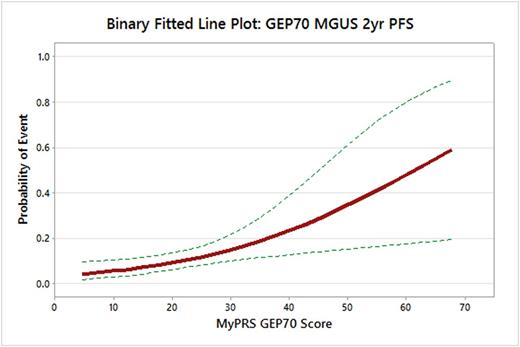Abstract
Background: The 70-gene prognostic risk score (MyPRS), originally developed by the University of Arkansas for Medical Sciences, is the most validated genomic assay for prediction of event free and overall survival in asymptomatic, newly diagnosed and relapsed multiple myeloma. Gene expression profiling was performed on CD138+ plasma cells obtained from the bone marrow of individuals with the precursor condition, monoclonal gammopathy of undetermined significance (MGUS), who later progressed to MM. Analysis of the 70 gene risk score vs. the probability of progression to MM requiring therapy was performed.
Method and Results: Between 2011 and 2015, MyPRS gene expression profiling of 266 individuals who initially presented with MGUS was performed. The mean length of time between MGUS diagnosis and disease progression or last follow-up was 6.9 years (standard deviation = 4.0 years). The mean length of time between MGUS gene expression profiling and either disease progression or date of last follow-up was 4.8 years (standard deviation = 2.9 years). Disease progression was defined as the development of CRAB criteria or bone marrow plasmacytosis exceeding 60%.
28 patients developed MM requiring therapy within two years of their MGUS GEP. Twelve individuals (5%) were classified as high risk using the previously established threshold for AMG (GEP70 >37.2 = high risk). Four high risk patients (33%) progressed to active MM within 2 years. 24/255 (9%) patients who were classified as low risk progressed to MM within the same length of time. A risk score histogram and binary fitted line plot of risk score vs. probability of progression to MM within 2 years were generated.
Conclusion: Performing MyPRS gene expression profiling on patients diagnosed with MGUS provides personalized information on the individuals' risk of progression to MM requiring treatment. While the overall rate of progression is low, approximately 5% of individuals are at higher risk and may benefit from increased monitoring. The 70-gene signature appears useful for identifying high risk behavior in MGUS patients thereby allowing early intervention and possible inclusion in clinical trials. MyPRS provides a risk assessment at a single point in time unlike recently reported metrics (ASCO Abs. # 8004) which measure a change in Hgb and M protein over time, along with bone marrow plasmacytosis, in order to determine the risk of progression.
van Laar:Signal Genetics, Inc.: Employment. Farmer:University of Arkansas: Employment. Bender:Signal Genetics, Inc.: Employment. Zielinski:Signal Genetics, Inc.: Employment. Leigh:Signal Genetics, Inc.: Employment. Brown:Signal Genetics, Inc.: Employment. Barlogie:Mount Sinai Hospital: Employment. Morgan:Univ of AR for Medical Sciences: Employment; Bristol Meyers: Consultancy, Honoraria; Takeda: Consultancy, Honoraria; Janssen: Research Funding; Celgene: Consultancy, Honoraria, Research Funding.
Author notes
Asterisk with author names denotes non-ASH members.



